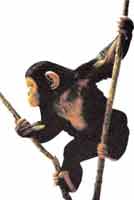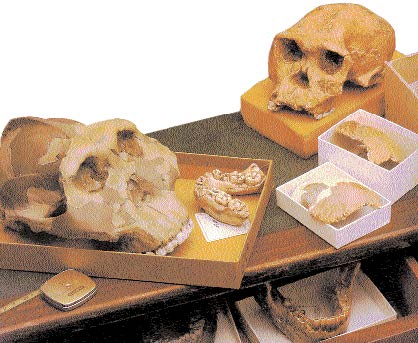Darwin put forward his claim that human beings and monkeys descended from a common ancestor in his book The Descent of Man published in 1871. From that time onwards, the followers of Darwin have tried to bolster this claim. But despite all the research that has been carried out, the claim of "human evolution" has not been backed up by any concrete scientific discovery, particularly in the fossil field.
 | THE DIVERSITY OF APES
Throughout history, more than 6,000 ape species have lived and most of them have been lost to extinction. The fossils of these extinct ape species constitute a rich resource for evolutionists. Evolutionists wrote the scenario of human evolution by arranging some of the skulls that suited their purpose in an order from the smallest to the biggest and scattering the skulls of some extinct human races among them. |  |
The man in the street is for the most part unaware of this fact, and thinks that the claim of human evolution is supported by a great deal of firm evidence. The reason for this incorrect opinion is that the subject is frequently discussed in the media and presented as a proven fact.
 |
Ernst Mayr, one of the founders of neo-Darwinism, admits that the scenario of "man's evolution" has found no evidence in the fossil record. |
But real experts on the subject are aware that the claim of "human evolution" has no scientific foundation. David Pilbeam, one of Harvard University's palaeontologists, says the following:
If you brought in a smart scientist from another discipline and showed him the meagre evidence we've got he'd surely say, 'forget it: there isn't enough to go on.'45
And William Fix, the author of an important book on the subject of palaeoanthropology, makes this comment:
There are numerous scientists and popularizers today who have the temerity to tell us that there is 'no doubt' how man originated. If only they had the evidence.46
This claim of evolution, which "lacks any evidence," starts the human family tree with a species of monkey called Australopithecus. According to the claim, Australopithecus began to walk upright over time, his brain grew, and passed through a series of stages to come to man's present state (Homo sapiens.) But the fossil record does not back up this scenario. Despite the claim of all kinds of intermediate forms, there is an impassable barrier between the fossil remains respectively of man and monkeys. Furthermore, it has been revealed that the species which are portrayed as each others' ancestors are actually contemporary species that lived in the same period. Ernst Mayr, one of the most important proponents of the theory of evolution in the 20th century, accepts this truth: "The chain reaching as far as Homo sapiens is actually lost."47
 |
THE FOSSIL RECORD DISPROVES EVOLUTION
The scenario of "human evolution" has no basis in the fossil record just as evolutionists' other scenarios about living species. Contrary to the propaganda spread by the media, there is no fossil evidence demonstrating that men and apes come from a common ancestor. |
47)Richard E. Leakey, The Making of Mankind, Michael Joseph Limited, London 1981, S. 43
48) William R Fix,. The Bone Peddlers, Macmillan Publishing Company: New York, 1984, S.150-153
49) Scientific American, Dezember 1992